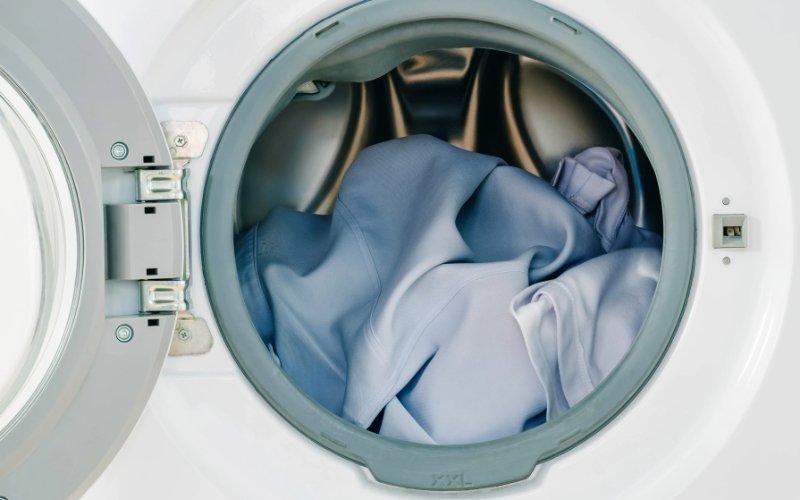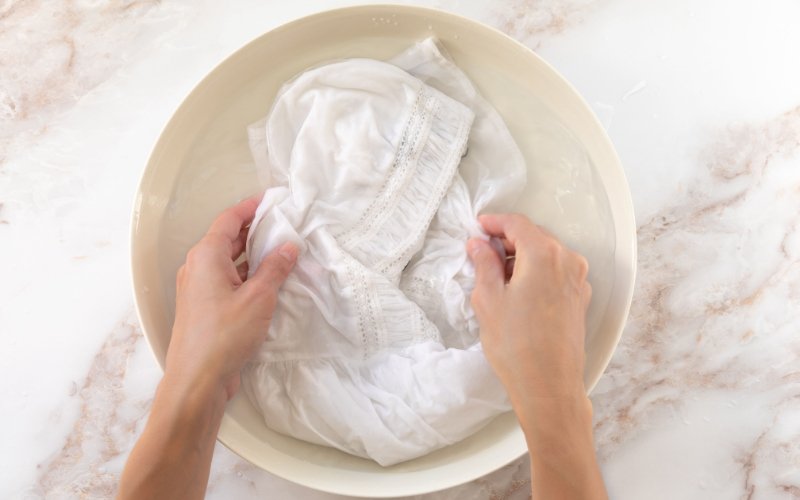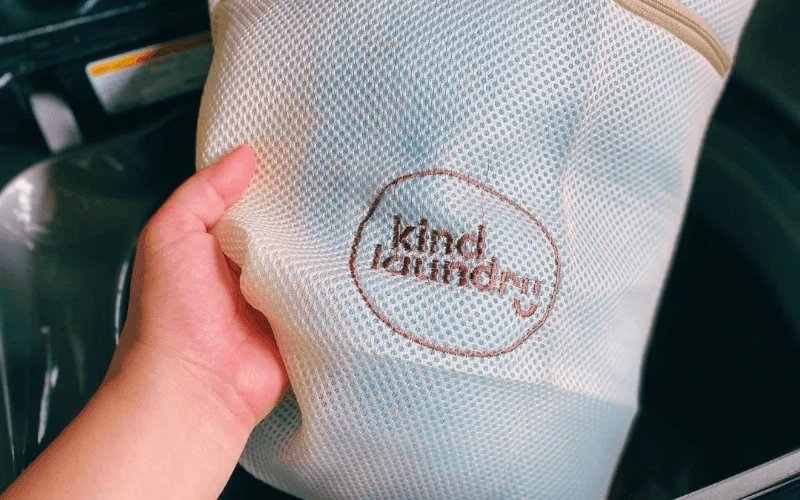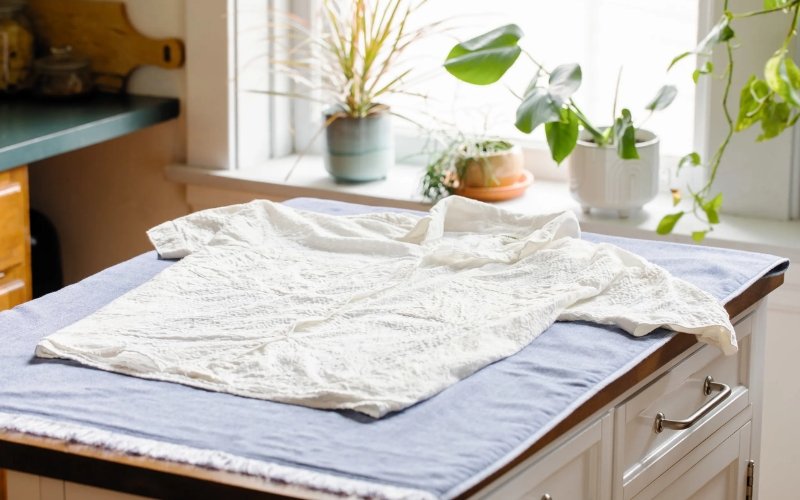Wash Delicates in Washing Machine: A Guide
Do you own delicate clothing items like luxurious lingerie, elegant silk scarves, or cozy wool sweaters? If so, you’ve likely felt that familiar hesitation before tossing them into the washing machine. The fear of snagging, shrinking, stretching, or fading these precious garments is real. Many people resort to time-consuming hand washing, but there’s a better way! This guide is for anyone who wants the convenience of machine washing their delicates without the risk of damage.
Washing delicate clothes incorrectly is not only frustrating, as it can ruin expensive items but also emotionally disheartening when cherished pieces are damaged. Proper washing is the key to extending the lifespan of these clothes, saving both money and preserving their beauty.
This comprehensive guide provides a clear, step-by-step process to safely machine wash delicates. We’ll empower you with the knowledge to confidently care for your delicate garments, giving techniques to choosing the right settings, detergents, and drying methods. You’ll master the art of keeping your delicates looking their absolute best, ensuring they remain wardrobe staples for years to come.
1. Understanding delicates: what fabrics need special care?
1.1 Identifying delicate fabrics
“Delicate fabrics” are those that are more prone to damage during washing than typical, sturdy materials. They are often lightweight, sheer, or have a loose weave, making them susceptible to snagging, shrinking, or stretching. Think of them like a beautiful, intricate piece of artwork – they require a gentler touch. These fabrics are commonly made from natural fibers like silk or wool, or specialized synthetics designed for a soft drape or luxurious feel.
1.2 Reading care labels: deciphering the symbols
The care label is your garment’s best friend, providing specific instructions from the manufacturer. It’s the ultimate authority on how to care for that particular item. Ignoring it is like ignoring a recipe and hoping for the best – you might get lucky, but you’re taking a risk.
| Laundry Symbol | Meaning | Implications for Washing |
|---|---|---|
| Hand Wash Only | Do not machine wash. Gently wash by hand in cool water with a mild detergent. | |
 | Machine Wash, Delicate Cycle | Machine wash using the delicate or gentle cycle, cold water, and a mild detergent. |
| Do Not Dry Clean | Do not dry clean. Other washing methods (hand washing or machine washing on delicate) may be suitable, depending on the fabric and care label. | |
 | Tumble Dry, Low Heat | Machine dry on a low heat setting. Air drying is often preferred for delicates. |
| Do Not Bleach | Do not use chlorine bleach. This can damage or discolor delicate fabrics. | |
 | Do not wring | Wring can damage delicate fabrics. |
1.3 Common delicate materials (silk, lace, wool, cashmere, rayon, etc.)
- Silk: A luxurious, natural fiber known for its smooth texture and sheen. It’s relatively strong but can be damaged by high heat and harsh chemicals.
- Lace: An openwork fabric, often made from cotton, linen, silk, or synthetic fibers. Its delicate structure makes it prone to snagging and tearing.
- Wool: A natural fiber known for its warmth and moisture-wicking properties. Wool can shrink and felt (become matted) if exposed to high heat and agitation.
- Cashmere: A type of wool that comes from the undercoat of Cashmere goats. It’s incredibly soft and luxurious but even more delicate than regular wool.
- Rayon: A semi-synthetic fiber made from cellulose. It’s known for its draping qualities, but it can be weaker when wet and prone to stretching.
- Modal: A type of rayon known for its softness and resistance to shrinkage. However, like rayon, it can be more delicate when wet.
- Synthetics: There are specific synthetics that is considered as delicate clothes
1.3.1 Washing silk
Silk, with its beautiful drape and luxurious feel, requires careful handling. Always use cold water, as hot water can cause the silk fibers to shrink or the colors to bleed. Choose a gentle detergent specifically designed for delicates or silk. Avoid twisting or wringing the silk, as this can damage the fibers and create wrinkles. If hand washing, gently swish the garment in the water.

1.3.2 Washing lace
Lace’s intricate patterns and open weave make it exceptionally vulnerable to snagging. Always use a mesh laundry bag to protect lace items during machine washing. This creates a barrier between the lace and other garments, preventing snags and tears.
Avoid harsh detergents, which can damage the delicate fibers. Hand washing is often the safest option for very delicate or antique lace. Always use a mesh laundry bag to protect lace items during machine washing

1.3.3 Washing wool and cashmere
Wool and cashmere are beloved for their warmth and softness, but they require special care to prevent shrinkage and felting. Cold water is essential, as hot water can cause the fibers to shrink dramatically. Avoid excessive agitation, which can cause the fibers to mat together (felting). Lay flat to dry, as hanging can stretch the garment out of shape. A gentle detergent designed for wool or cashmere is recommended.

1.3.4 Washing rayon and modal
Rayon and modal are known for their soft, draping qualities, but they can be more delicate when wet. Always check for colorfastness before washing, especially with brightly colored items. A simple test involves dampening a small, inconspicuous area and blotting it with a white cloth.
If any color transfers, wash the item separately. Avoid high heat, which can cause shrinkage or damage. The gentle cycle on your washing machine is the best option, and a mesh bag provides added protection.

2. Preparing your delicates for the wash
2.1 Sorting delicates: by color and fabric type
Sorting delicates is a crucial step in preventing damage and ensuring a thorough clean. It’s like organizing a delicate ecosystem – each element needs its own space to thrive. Color bleeding is a primary concern. Dark-colored fabrics can release dye, staining lighter-colored items.
Always separate lights from darks, and wash similar colors together. Beyond color, consider fabric type. Washing a silk blouse with a heavy wool sweater can cause the silk to be damaged by the heavier fabric. Group similar fabrics together: silks with silks, laces with laces, woolens with woolens, etc.

2.2 Pre-treating stains: gentle stain removal techniques
Gentle stain removal is key to preserving the integrity of delicate fabrics. Harsh chemicals and aggressive scrubbing can cause more harm than the stain itself. Blot, don’t rub, any spills or stains immediately. Rubbing can spread the stain and damage the fibers. Use a mild detergent solution, white vinegar, or baking soda paste, depending on the type of stain and fabric.
| Stain Type | Recommended Treatment |
|---|---|
| Oil-based | Blot with a clean cloth, then apply a mild detergent solution. |
| Water-based | Blot with a clean cloth, then rinse with cold water. |
| Protein-based | Soak in cold water, then apply an enzyme cleaner. |
| Tannin-based | Rinse with cold water, then apply white vinegar. |
Before applying any stain remover, always test it on an inconspicuous area of the garment (like an inside seam) to ensure it doesn’t cause discoloration or damage.
2.3 Protecting delicates: using mesh laundry bags
Mesh laundry bags are essential for protecting delicates in the washing machine. They act as a shield, preventing snagging, tangling, and stretching. Think of them as individual protective cocoons for your delicate garments. Place each delicate item (or a few very similar items) in its own mesh bag. Don’t overcrowd the bags; the garments need room to move freely for proper cleaning.

Fastening closures – zippers, hooks, buttons, and snaps – is a simple but often overlooked step. Loose closures can snag on other items in the wash, causing damage. Zippers can scratch delicate fabrics, and hooks can snag lace or open-weave materials. Taking a few seconds to fasten all closures before placing items in the washing machine (or mesh bags) can prevent these problems.
3. Machine washing delicates: step-by-step instructions
3.1 Choosing the right detergent: gentle and effective options
Selecting the appropriate detergent is critical for washing delicates. Harsh chemicals and strong cleaning agents found in conventional detergents can damage delicate fibers, causing fading, shrinking, or weakening. Gentle detergents are specifically formulated with milder ingredients. Liquid detergents are generally preferred for delicates because they dissolve completely in water, reducing the risk of residue buildup that can irritate sensitive skin or damage fabrics.
While specific brands like Woolite, Dreft, All Free Clear, and The Laundress are popular choices, the key is to look for detergents labeled “gentle,” “for delicates,” or “pH-balanced.” These formulations often contain fewer harsh chemicals and enzymes that can break down delicate fibers.
3.2 Selecting the correct washing machine settings: delicate cycle explained
The delicate cycle, sometimes labeled “hand wash” or “gentle,” is specifically designed to mimic the gentle action of hand washing. It uses a combination of lower agitation (less tumbling), a shorter wash time, and a lower spin speed to minimize stress on delicate fabrics.
This gentle approach helps prevent stretching, snagging, and damage. The location and labeling of the delicate cycle may vary depending on the washing machine brand and model (top-loading or front-loading). Consult your washing machine’s manual if you’re unsure how to find it.
3.3 Water temperature: why cold water is key
Cold water is almost always the best choice for washing delicates. Hot water can cause many delicate fabrics, especially natural fibers like silk and wool, to shrink, fade, or become damaged. The heat can weaken the fibers and cause colors to bleed.
Cold water, on the other hand, is much gentler and helps preserve the integrity of the fabric and its color. There might be rare exceptions based on specific care label instructions, but cold water is the safest default.

3.4 Loading the washing machine: avoiding overcrowding
Overcrowding the washing machine is a common mistake that can negatively impact the cleaning process and increase the risk of damage to delicates. When the machine is too full, clothes don’t have enough room to move freely, resulting in reduced cleaning effectiveness.
Delicates are more likely to be crushed, wrinkled, or even damaged due to the increased friction and pressure. A good rule of thumb is to load the machine loosely, allowing ample space for the garments to move around during the wash cycle. Wash only a few delicate items at a time, especially if they are particularly fragile or valuable.
4. Drying delicates: preserving shape and quality
4.1 Air drying: the best method for delicates
Air drying is the gentlest and most recommended method for drying delicates. It avoids the heat and tumbling action of a machine dryer, which can cause shrinking, stretching, fading, and damage to delicate fibers. Air drying allows the garments to dry slowly and naturally, preserving their shape and quality.
4.1.1 Hanging delicates properly
While air drying is ideal, improper hanging can lead to stretching or misshapen garments. Use padded hangers to distribute the weight of the wet fabric evenly and prevent sharp creases or hanger marks. Avoid using clothespins directly on delicate fabrics, as they can leave indentations or cause stretching. If using clothespins, place them on seams or less noticeable areas.
4.1.2 Laying delicates flat to dry
Laying delicates flat to dry is particularly important for items that are prone to stretching, such as sweaters and knits. Place a clean, dry towel on a flat surface (like a table or drying rack). Gently reshape the garment to its original form and lay it flat on the towel. Avoid direct sunlight or heat sources, which can cause fading or damage.

4.2 Using a drying rack: maximizing airflow
A drying rack is a valuable tool for air-drying delicates. It provides increased airflow around the garments, promoting faster and more even drying. The open design of a drying rack allows air to circulate freely, reducing the risk of mildew or musty odors. Ensure that delicate items are properly spaced on the rack, allowing for adequate airflow between them.
4.3 Avoiding the dryer: why heat can damage delicates (with exceptions)
Machine drying is generally not recommended for delicates. The high heat and tumbling action can cause shrinking, fading, and irreversible damage to delicate fibers. However, some dryers have very low heat settings or an “air fluff” cycle (which uses no heat).
These settings might be suitable for some delicates, but always check the care label first and proceed with extreme caution. Even on a low heat setting, there’s still a risk of damage, so air drying is always the safest option. The “Do Not Tumble Dry” symbol on a care label is a clear indication to avoid the dryer completely.
4.4 Reshaping garments
After washing the delicate, it can be slightly deformed during washing and before drying. Gently smoothing and reshaping garments that helps them retain their original form. Smooth out wrinkles, gently tug seams back into place, and ensure the garment is lying or hanging in its intended shape. This is especially important for knits, which can easily stretch out of shape when wet.
5. Storing delicates
5.1 Folding vs. hanging
The best way to store a delicate item depends on its fabric and construction.
- Folding: Items made of knit fabrics (sweaters, cashmere, etc.) are best folded to prevent stretching. Use acid-free tissue paper between folds to minimize wrinkles and prevent snagging.
- Hanging: Woven fabrics (silk blouses, dresses, etc.) are often best hung on padded hangers to maintain their shape and prevent wrinkles.
5.2 Protecting from moths and humidity
Moths and humidity can damage the clothes. To protect them:
- Use cedar blocks or lavender sachets in drawers and closets to repel moths.
- Store delicates in a cool, dry place to prevent mildew and damage from humidity. Avoid storing them in plastic bags, which can trap moisture. Breathable garment bags or cotton storage boxes are better options.

6. Troubleshooting common problems
6.1 Preventing snagging and tearing
Snagging and tearing are common concerns with delicate fabrics. Reinforcing previous advice is important for emphasis:
- Mesh Bags: Always use mesh laundry bags to protect delicates during washing.
- Fasten Closures: Ensure all zippers, hooks, and buttons are fastened before washing.
- Sorting: Separate delicates from items with rough textures or hardware that could cause snags.
- Inside Out: Turn the delicate clothes inside out to decrease friction.
6.2 Dealing with shrinkage
If shrinkage occurs, it’s often irreversible, especially with natural fibers like wool and silk. However, sometimes gentle stretching while the garment is damp can help regain some of the original shape. For knits, blocking (stretching and pinning the garment to specific measurements while it dries) can be helpful. However, prevention is key: always follow care label instructions and use cold water.
6.3 Avoiding color bleeding
Color bleeding can ruin delicate garments. Reinforce the importance of sorting:
- Sort by Color: Always wash lights with lights and darks with darks.
- Cold Water: Use cold water to minimize dye release.
- Color Catcher Sheets: Consider using color catcher sheets (dye-absorbing cloths) in the wash, especially when washing new or brightly colored items.
6.4 Addressing stretching and misshapen garments
If a delicate garment has stretched or become misshapen, gentle reshaping while it’s damp can sometimes help. For knits, blocking (as described above) can be effective. However, prevention is crucial: avoid hanging heavy knits when wet, and always lay them flat to dry.

7. Related questions
7.1 Can I wash delicates with regular clothes if I use a mesh bag?
While a mesh bag provides protection, it’s generally not recommended to wash delicates with regular clothes. Regular clothes often require a more vigorous wash cycle and hotter water, which can still damage delicates even within a mesh bag. The weight and texture of regular clothes can also put stress on delicates. It’s best to wash delicates separately.
7.2 What if my washing machine doesn’t have a delicate cycle?
If your washing machine lacks a dedicated delicate cycle, use the shortest, gentlest cycle available. This might be a “quick wash” or a cycle designed for lightly soiled items. Most importantly, select cold water and a low spin speed. Hand washing is always a safe alternative if you’re unsure.
7.3 How can I tell if a garment is truly “delicate”?
Refer back to the fabric types discussed earlier (silk, lace, wool, cashmere, rayon, modal, and certain synthetics). Check the care label for instructions like “hand wash,” “delicate cycle,” or “dry clean.” If you’re still unsure, err on the side of caution and treat the garment as a delicate.
7.4 Is fabric softener safe for delicate clothes?
Generally, it is not recommended using fabric softener for delicate clothes. Or use a very small amount of a gentle fabric softener that is designed for delicates.
7.5 How often should I wash my delicates?
The frequency of washing depends on how often the item is worn and how close it is to the body. Undergarments worn next to the skin should be washed after each wear. Other items, like sweaters or dresses, can be washed less frequently, depending on how soiled they are.
Read more:
Washing delicates might seem intimidating, but with the right knowledge and techniques, it becomes a manageable and even rewarding task. The key is gentle care: gentle detergents, gentle cycles, gentle drying, and gentle handling.
By following the steps outlined in this guide, you can confidently wash your delicate clothes in the washing machine, protecting your investment and ensuring they remain beautiful and wearable for years to come. Embrace the confidence that comes with knowing how to properly care for your most cherished garments.


















